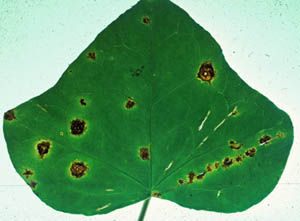Ivy Leaf Spot | |
|---|---|
| May 9, 2008 | |
|
English ivy (Hedera helix) is a popular ground cover in shaded locations. It is susceptible to two diseases with very similar symptoms. The first is bacterial leaf spot, which first appears as small, circular, dark green, and water-soaked (oily-looking) areas on ivy leaves.  Spots enlarge and have a red–brown to black center, with a water-soaked margin. Sometimes a yellow halo appears around the lesion. Stems may be infected as well. Spots enlarge and have a red–brown to black center, with a water-soaked margin. Sometimes a yellow halo appears around the lesion. Stems may be infected as well. The other disease is caused by one of several fungi. In general, fungal leaf spots of ivy are described as red to brown in color and irregular in shape. Certain fungal species may cause lesions to have concentric rings or depressed centers. Fungal leaf spots form fruiting bodies that contain spores. These fruiting bodies are small (pinhead-sized), black, and embedded within the leaf spot.  Although these descriptions seem different, the bacterial lesions appear like the fungal disease when dry. If you can look at fresh tissue, you can better distinguish these diseases and choose the proper control. Both pathogen groups are spread in splashing water. Do not work with plants when they are wet, or you may spread the pathogen within the ivy planting. For more information about these diseases, refer to Report on Plant Disease (RPD), no. 652, “Leaf Spot Diseases of English Ivy,” available at http://www.ag.uiuc.edu/~vista/horticul.htm or in printed form at University of Illinois Extension offices. | |
| Author: | Nancy Pataky |
